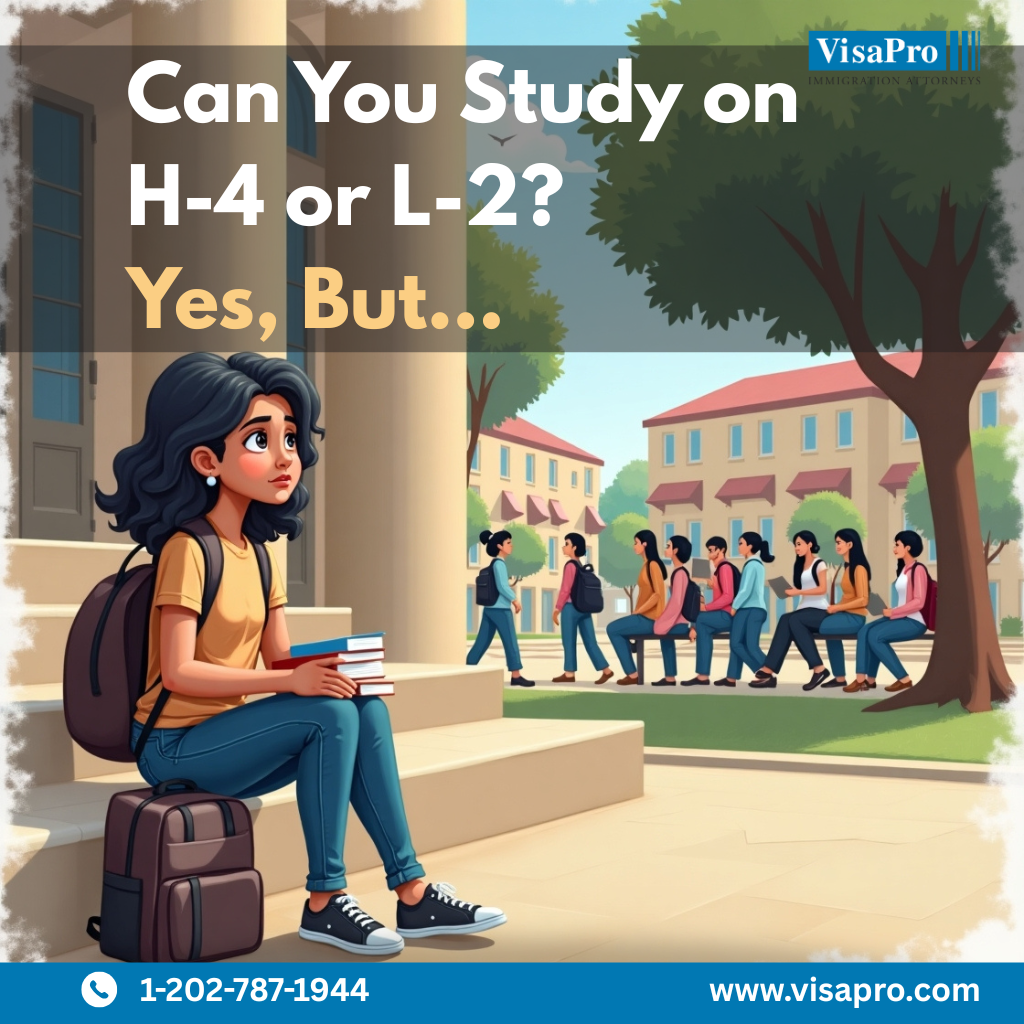Quick Summary:
If your child is planning to study in the U.S., choosing between staying on H-4, L-2, or other types of dependent visas or switching to F-1 can feel overwhelming, especially with college decisions looming and immigration timelines uncertain. This guide explains the pros and cons of each option, especially for parents on H-1B or L-1 visas, so you can confidently decide what’s best for your family’s future.
Note: Most of the information here applies to almost all dependent visa categories for dependent children.
Understanding Which U.S. Visa Option Is Best For Your Child’s College Education
A dependent child can attend school in the U.S. on an H-4, L-2, or F-1 visa.
Each path has different implications for work authorization, tuition costs, and long-term planning. While H-4 and L-2 are easier in the short term, F-1 offers more independence and career benefits but requires more paperwork and expense.
Many immigrant parents face this dilemma: Should my child continue as a dependent on an H-4 or L-2 visa? Or switch to an F-1 international student visa to study independently?
Let’s break it down through real-world guidance, legal insights, and practical comparisons.

Can My Child Study in the U.S. On an H-4 or L-2 Visa?
Yes, children holding valid H-4 or L-2 visas can legally attend school or university in the U.S. as long as they maintain H-4 or L-2 status.
They do not need an I-20 or F-1 visa to enroll. However, they cannot work or participate in internships while in H-4 or L-2 status.
Scenario Example:
A 18-year-old student has been accepted to St. Louis University. His father holds an approved H-1B. The son can begin his undergraduate studies on an H-4 visa as a dependent- no I-20 required. However, he cannot work on campus or apply for internships under H-4.
Key Considerations:
- No separate visa process needed if already in the U.S. on H-4 or L-2.
- No on-campus or CPT/OPT work permitted for H-4 or L-2 holders unless status is changed.
- Fewer costs and simpler entry for children already accompanying their parents.
- Children on H-4 or L-2 may be eligible for more affordable tuition rates, and in some states, “in-state” tuition
Practical Tip:
If you’re planning to keep your child on H-4 or L-2, make sure to track their age. The moment they turn 21, they “age out” and must move to a different visa status, most commonly F-1.
What Are the Benefits of Switching from H-4 or L-2 to F-1?
Switching from H-4 or L-2 to F-1 opens up employment and career-building opportunities.
F-1 visa holders can work part-time on campus, apply for Curricular Practical Training (CPT), and be eligible for Optional Practical Training (OPT) after graduation.
Scenario Example:
A student on H-4 wants to pursue a Computer Science degree and secure a tech internship. He cannot do this on H-4. By applying for a change of status from H-4 to F-1, he becomes eligible for CPT during studies and OPT afterward, both critical for STEM careers.
Key Considerations:
- Work Authorization – On-campus jobs, CPT for internships, OPT post-degree
- Better Long-Term Planning – Prepares the student for H-1B or green card paths
- Independence from Parents’ Visa – No risk of status disruption due to parental job loss
- International Student Tuition- International students often pay higher tuition rates and may not be eligible for certain types of private loans, grants, and scholarships

When Should You Change from H-4 or L-2 to F-1?
Your child must plan on obtaining F-1 status before they turn 21.
A child aging out of dependent status must obtain a new visa status. Failing to do so in time can result in unlawful presence.
Scenario Example:
A student starts freshman year on H-4 at age 18. They must initiate the H-4 to F-1 process at least 6–12 months before turning 21 to ensure uninterrupted status. Alternatively, they can travel abroad and obtain an F-1 visa at a U.S. Consulate and return to the U.S. on or before their 21st birthday.
Checklist:
- Is your child within 1 year of turning 21?
- Will they need CPT or OPT?
- Is your family’s H-1B or L-1 status ending in the next 2-3 years?
If the answer is “yes” to any of the above, the F-1 visa might be the better choice now.
What Is the H-4 to F-1 Change of Status Process?
The H-4 to F-1 process involves obtaining an I-20 from the school and filing Form I-539 with USCIS.
This is not automatic, it’s a formal request for a change of nonimmigrant status.
Step-by-Step Guide for H-4 to F-1 Process:
- Receive Admission & I-20
The school issues Form I-20 once the student is accepted. - Submit Form I-539
File this with USCIS to change status. Include supporting documents and fees. - Wait for USCIS Approval
Standard Change or Status F-1 processing time ranges from 6 to 12 months. Processing time can be reduced to 30 business days with Premium Processing. - Remain in the U.S. while waiting
The student cannot depart the U.S. while the change of status is pending.
Alternate Option:
Some families prefer applying for an F-1 visa at a U.S. consulate abroad to bypass USCIS delays, but that comes with risks (visa interview questions, potential rejections without opportunity to appeal, etc.).
H-4 to F-1 Processing Time Tip:
Start the change of status process at least 9–12 months before turning 21 or before you need CPT/OPT eligibility if you want to avoid Premium Processing.
What Happens if You Wait Too Long? H-4 to F-1 Age-Out Risks
Children automatically lose H-4 or L-2 eligibility at age 21.
Without a timely switch to F-1, they may fall out of legal status, putting their education and immigration future in jeopardy.
Scenario Example:
An H-4 or L-2 dependent continues studying and turns 21 mid-semester without filing a change of status. They are now out of status and may be required to leave the U.S.
Avoiding This Risk:
- Start planning at age 19–20.
- Speak to your DSO (Designated School Official) early.
- Consult an immigration attorney to time the transition effectively.
What Are the Costs of F-1 vs. H-4 or L-2?
F-1 students usually pay higher fees and must show proof of funds.
Many universities charge international tuition rates to F-1 visa holders. Plus, F-1 students need to demonstrate the ability to cover living and tuition expenses.
F-1 Financial Requirements:
- Bank statements or financial affidavit.
- SEVIS fee payment ($350).
- Proof of sponsor (if applicable).
In contrast:
Students on H-4 or L-2 may be eligible for in-state tuition depending on the university’s residency policies and may have access to a greater range of loan and grant options.
Tip:
Check your state’s tuition policy. Some states grant in-state tuition to H-4 and L-2 visa holders who attended high school in the state.
Final Thoughts: Which Visa Should Your Child Use?
If your child is younger than 20 and not planning to work during college, starting on H-4 or L-2 can be simpler.
But for those nearing age 21 or aiming for internships and post-grad employment, switching to F-1 is the better long-term move.
Take Action Now:
Don’t wait until deadlines loom. Contact VisaPro today for a free personalized assessment to plan your child’s education and visa strategy. Our immigration lawyers have helped hundreds of families navigate these pivotal decisions with confidence.
FAQ: Dependent H-4, L-2, and F-1 Visa Questions Answered
1.Can I study full-time on an H-4 or L-2 visa without changing to F-1?
Yes, H-4 and L-2 visa holders can study full-time in the U.S. without an I-20 or changing to F-1. However, they cannot work on campus or apply for CPT or OPT unless they switch to F-1 status.
2.When should I apply for a change of status from H-4 to F-1?
In order to avoid Premium Processing, it’s best to apply at least 9–12 months before your child turns 21 or before they need work authorization for internships or OPT. Processing delays can jeopardize status if not timed correctly.
3.Is there H-4 to F-1 premium processing?
Yes, USCIS does currently offer premium processing for Form I-539 for change of status to F-1. Premium Processing is 30 business days (the clock starts once Biometrics is taken, if needed).
4.What are typical H-4/L-2 to F-1 visa interview questions if we apply at a consulate?
Questions may include: Why are you switching to F-1? How will you fund your education? What’s your academic plan? Be prepared with documents proving intent to study and sufficient finances.
5.What’s the process for H-4 or L-2 to F-1 change of status?
The student must obtain an I-20 from a school and file Form I-539 with USCIS. Timing is critical to avoid falling out of status at age 21.
Need Help Planning the Transition From H-4 or L-2 to F-1?
Talk to VisaPro’s experienced immigration attorneys. We’ll guide you step-by-step through the change of status process, avoid costly mistakes, and ensure your child’s academic and immigration future stays secure.
👉 Schedule Your Free Visa Assessment With VisaPro
What VisaPro Customers Are Saying
The US [B-1] Visa has always been a tough ride, and being denied a few times it makes it even worse. But thanks to VisaPro and their meticulous processing I was granted a Visa. I would like to thank you and all the people involved in making this a success. I would like to recommend VisaPro to all those who seek peace of mind and hassle free Visa processing.”



 Manas Bhat, Director Operations, First Houston Mortgage India
Manas Bhat, Director Operations, First Houston Mortgage India

